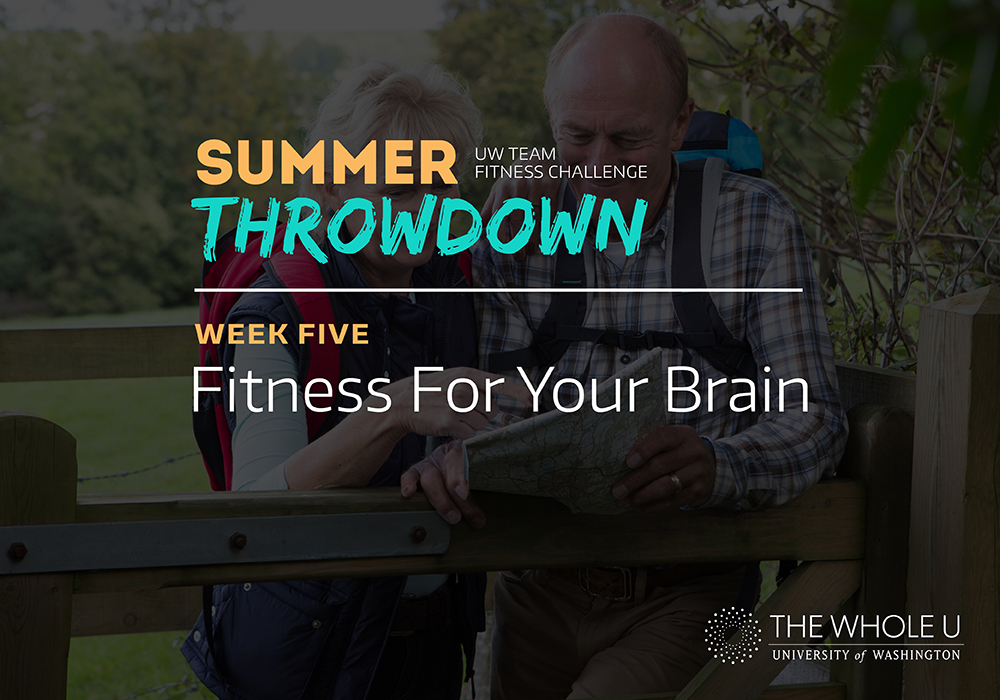
Summer Throwdown Week 5: Brain Health
Have you ever felt great after working out? Not just proud of yourself, but physically great? Chances are you have. That’s because moving your muscles releases chemicals in your brain. But working out does more for your brain health than just releasing those sweet, sweet endorphins.
When people feel happy, their productivity increases, their relationships improve, and they get better at coping with the challenges and unpredictability of life. For week five of the Summer Throwdown challenge, we’re going to look at how working out can boost our brain health.
To start things off, I asked Hall Health Psychologist Meghann Gerber what her thoughts are on the brain benefits of exercise.
“As a psychotherapist, I frequently observe how engaging in physical exercise can be very helpful for stress reduction, improving one’s energy, ameliorating the effects of anxiety and decreasing symptoms of depression,” Gerber wrote in an email. “Physical fitness is also supportive of brain functions like the ability to attend to certain stimuli and ‘screen out’ other background stimuli, and supports the growth and development of brain cells required for new learning.”
So, how does that work? Let’s take a look.
New neuron support
We lose thousands of nerve cells daily, but building new neurons keeps our synapses firing the way we need them to. According to an article from Psychology Today, physical exercise helps the release of the brain-derived neurotrophic factor (BDNF), a gene that promotes the survival and wellbeing of your neurons. Our synapses change and adjust over time depending on our new experiences, and the BDNF helps maintain this “synaptic plasticity” that’s essential to our memory and learning functions.
An Australian study from 2014 showed that this type of brain function doesn’t even wait to happen in the long term. After asking a small group of participants to ride exercise bikes for 30 short minutes, the Australian research team observed noticeable changes. Just 15 minutes after their workout, the subjects involved in the study showed physical, functional, and chemical improvements.
As people age, their brains naturally shrink and slow down, but just by getting some sort of exercise regularly, you set yourself up for an even better retirement by making those brain power improvements stick. Older adults with active lifestyles outperform their more sedentary peers in memory and accuracy with cognitive tasks. Not only that, but more active adults tend to have bigger brain volumes.
Better brain food and flow
Of course, making sure the blood in your brain flows is essential. When you work your blood up and around your brain matter, it increases the amount of oxygen your cells receive, making them function better. That feeling of clarity you get after a brisk walk? It’s due to the increasing amount of blood flow to your brain, particularly your hippocampus. When we’re highly active, the hippocampus and highly active, and because of its role in learning and memory, we feel refreshed and focused once we get moving.
Physical activity helps your brain eat well, too. You may have heard the term brain food, but if you take a closer look, it’s easier to understand how physical fitness might play a role in how effective your brain food is. When a person’s brain is busy working, the neurons need food to do their job, like the rest of the cells in our body. But when the metabolic rate of your blood sugar levels isn’t well-regulated, your brain might not be getting the food it needs to function properly when it needs it.
A regular fitness routine or commitment can help regulate the glucose going to your head, which in turn can help you avoid chronic diseases. An article from The Scientist shared that folks with “metabolic disturbances” or irregularities in their blood sugar levels have been repeatedly linked to depression, Huntington’s, and Parkinson’s disease.
Avoiding Alzheimer’s and Stroke
A recurring theme in my research about better brain health concerned Alzheimer’s, an illness that over 5 million Americans live with. Like all of your other muscles, the brain needs to be used, but instead of playing word puzzles or mind games, keeping your body healthy through physical fitness is actually just as — if not more — beneficial.
According to the Alzheimer’s Association Research Center, conditions like high cholesterol, diabetes, and high blood pressure all contribute to the risk of developing Alzheimer’s, so keeping your body fit and exercising different parts of your brain can help you maintain good mental health. In fact, a study published in Texas noted that folks who exercise and improved their memory performance also showed a greater increase in blood flow to the hippocampus, a key part of the brain impacted by Alzheimer’s disease.
Through fitness or some kind of physical training, you can also decrease your risk of stroke by up to 80%. Strokes are the fifth leading cause of death in the U.S., as well as one of the leading causes of permanent disability. Keeping your blood pumping to avoid them.
Of course, physical exercise is not a complete solution for specific mental health concerns, nor a replacement for treatment from a licensed professional, but Gerber told me that it is one of the key pillars of improving your holistic health — especially for your brain.
“Exercise, and especially cardiovascular activity, is associated with improved health to brain regions responsible for important functions like memory and complex problem solving,” Gerber wrote. “This is why physical activity is important as we age for maintaining our minds as well as our bodies.”
Most people probably focus on how financially stable they’ll be in their older years. But it’s clear that considering a workout today is a benefit to your brain function tomorrow.